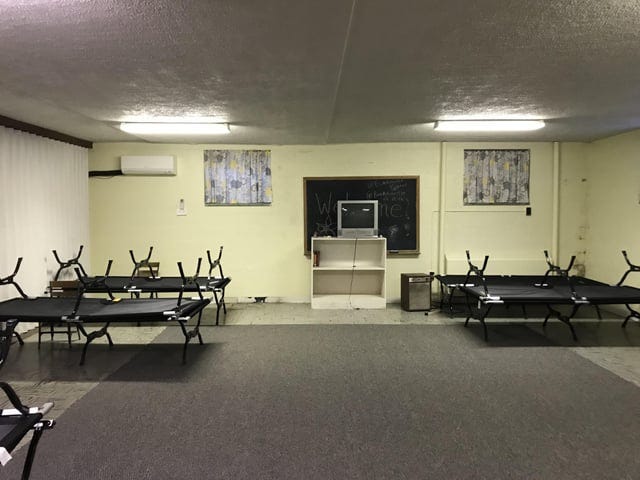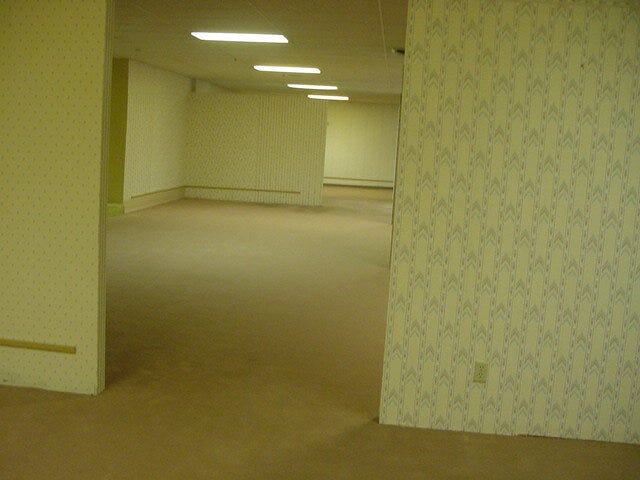Back in 2019, the phrase “Liminal Space” exploded all over the internet when a creepypasta entitled “The Backrooms” went viral on 4Chan. The story displayed a picture similar to the one above and described an eerie “out of bounds” labyrinth of endless mono-yellow hallways saturated with the smells of moist carpet and dead silence but for the incessant buzzing of light fixtures. The post made a splash and kicked off an entire wave of Liminal Space photos (some real and some generated by AI) and eventually they took on a mythology of their own, becoming the homes of dead dreams and mysterious entities.
But as I so commonly ask on this Substack, what about this connected with people? What part of our lived experience do these photos and the strange stories attached to them resonate with?
EMPTY MEMORIES
One of the most striking elements of these pictures are their emptiness. Dead malls, drained swimming pools, and abandoned apartment complexes all feature heavily and one of the uniting features is that these are all places that people were.
In an essay on the subject, writer RAMCPU states:
“The reason why we are fascinated with these images of vacant, abandoned, and eerie locations is that, for the most part, they represent the false promises of the modern era. Perhaps, the best liminal space photos are the ones that show some sort of modern architecture. It could be a home, a commercial property, or the inside of a hotel or mall. These photos usually have no human subjects in the photos and in some cases, the interior spaces have no windows at all.”
RAMCPU seems to be saying here that, deprived of their utility, these utilitarian structures are unmasked as the horrid, ugly, and soul-draining works they actually are. There’s no art to them. No soul. They aren’t products of people but of The Machine. The fact that they can be so easily rendered by AI right now speaks to just how inhuman this architecture really is.
I’ve been known for saying in the past (as the name of this Substack indicates) that half of the problems the Church is facing in the West would be solved if they simply started putting gargoyles on the edges of their buildings again. Now, this is SOMETHING of a joke but not entirely. I don’t think gluing a bunch of monsters to church buildings would actually solve a lot, but I DO think that a lot would be solved if the Church once again became a people INCLINED to put gargoyles on the sides of their buildings.
Because if they’re putting gargoyles on the sides of buildings, that means that they once again care about the aesthetics of things. If we start putting these macabre little monsters back in their proper architectural spaces then that almost certainly will have been proceeded by a complete reworking and re-beautifying of everything inside of the church building first, including ourselves.
Right now, modern church buildings are deeply reflective of our own attitudes toward the world. There are a lot of hard lines, empty spaces, and bare walls. Spaces are either meant to funnel or contain, rather promote contemplation. We live for utility and function and beauty is just something that the cutsie artists can tinker with in the corner.
If it’s good, maybe we’ll even hang it up on the fridge.
When I saw firsts saw pictures of Liminal Spaces online, the first thing I thought of were youth group basements. There was the bad carpeting, the dank smell, and just the faintest whiff of desperation.
What does it mean that these places, now transmogrified by time in our heads, are empty and cored out? And I’m not just speaking about church basements now but the inescapable sense of rotting nostalgia attached to all of these images.
In the climax to his 2022 album, Milk Teeth, Tyson Motsenbocker sings:
I wanna go back and just shout through the void to change course But there's no one there that can hear it 'Cause time is a one-way mirror Time is a one-way mirror
Often times, we have this feeling that we can step into our own nostalgia as if it were a room, but if that were the case, who would be there to join us? Everyone else has moved on. The rooms are empty. The one-way mirror of time shows us what was, not what is.
And so this is how it feels to see these derelict rooms. We feel like we’re the only ones there. As if those experiences that we thought we had shared with others were actually nothing more than bright wildflowers destined to die with the changing of the seasons. In our failure to transmute the joy of the past into the joy of the present, we find ourselves emptyhanded.
And now, in the coming winter of our lives, we return to those memories for some sort of sustenance and find that there’s nothing to go back to.
A FAILURE OF THRESHOLD
In anthropology, the word "liminal" refers to a transitional state between pre-initiated individuals and post-initiated individuals. There's often a lot of ceremony and structured process surrounding these transitions and they have been part of human history for as long as anyone remembers.
Victor Turner, however, goes on to explain that there is also a kind of counter or subset of liminality he calls "Liminoid" which has the same characteristics of between-ness and transition but without the structural boundaries or spiritual guides.
Think of the difference between Divine Liturgy on a Sunday morning and a rock concert. There’s a lot more spontaneity in the rock concert but you might also get kicked in the face, which is significantly less likely during the Divine Liturgy.
In their deep distrust of all things ritualistic American Evangelical churches have veered away from the boundaries of liminal spaces and into the spontaneity of the liminoid, opting for rock concert worship services instead of traditionally grounded communal hymnals. The problem they’re facing now though is that, if you’re going to hop onto the bullet train of liminoid spontaneity, you have to become extremely fluid and flexible. You have to be ahead of the curve, not six years behind it as evangelical music so often is.
When you’re not right on top of it the music grows stale. The trends hollow out. Meaning is leeched away.
This is the difference between fashion and tradition. One is slow-moving but long-lived like a sea turtle whereas the other is like a rabbit: fast, multitudinous, and dying in droves.
So what does this have to do with the Liminal Space aesthetic phenomenon?
Simply this: we’ve grown so accustomed to transition without boundaries that we don’t even know the difference between liminal and liminoid anymore. We can’t discern between a helpful place of transformation and one where we might get torn apart. In our distrust of the sacred and jettisoning of spiritual elders, all that’s left is the liminoid.
Psychedelics and the Sacred Interior
The Joe Rogans of our world are just smart enough to recognize the transformative powers of things like psychedelics but not wise enough to realize that these things require guardrails or you run the risk of breaking your own mind in a kind of Lovecraftian meltdown.
Being a relatively open person, folks have asked if I would ever try something like peyote or ayahuasca and my official answer is that I would only ever try it under these conditions:
I’m being guided through the encounter by a spiritual leader that I trust who has actual experience leading things like that.
It’s with a hallucinogenic specific to my own ethnic region of origin.
I have a community ready to receive me back into it and act as a sort of “spiritual pressure-release chamber.”
All of those specifications are so far off from the place and community I live in that I would urge you not to hold your breath on this.
But that is what we're seeing currently with these "back rooms" and "liminal spaces.” They represent the raw transformation of a liminoid experience you might buy at a gas station rather than work your way up to in a community.
We're struck by these pictures of transitional spaces that have no spiritual guideposts because they're an accurate reflection of where we are. We feel the implicit unease of them tinged by familiarity. We're a culture "lost in the woods" as it were, gobbling down psychedelics in doses a hundred times more powerful than our ancestors ever did, not as some labor towards wisdom but as a shortcut towards it. We’re a people who have ventured out into transformative space but--due to our lack of spiritual awareness--have never made the return journey and are only comfortable in the bog because we’ve forgotten the warmth of the hearth at home in the village.
Proper initiations have three key stages: severance, threshold, and return. And we are currently stuck in the threshold stage, both as individuals and as a civilization.
Which is why most of these liminal images feature a sort of comfortable nostalgia mixed with unease, alienation, or abandonment. These are not renderings of our past but reflections of our present. Our sacred spaces, whether personal (like a childhood home) or communal (like a church or rec center or shopping mall) are no longer the centers they once were. A piece of us has been lost to them and we don't know how to recover it. We're always seeking transformation but never integration.
In a sense, our souls are these empty and abandoned places, where the echoes of the past are so loud we can't adequately form a vision of the future. Our Sacred Interiors have become exiled to us and we return to them as we might an overgrown garden. These are places where our severed childhoods act like ghosts walking from room to room, desperate to break into our adult lives.
So what do we do about it?
Pray. Meditate. Contemplate. Find a spiritual mentor. Dig up the poisoned silence these pictures hold and baptize it into a silence that is substantive and nutritious. Turn the moldy back rooms of your childhood into the internal sacred spaces of your adult life. Let those memories be honey rather than thorns.
You’ve gone out into the wilderness, now it’s time to find that Water of Life and return.
For further reading on the anthropology of liminal spaces, check out:
The Archetype of Initiation by Robert L. Moore
https://www.amazon.com/Archetype-Initiation.../dp/073884764X
The Sacred and Profane by Mircea Eliade
https://www.amazon.com/Sacred-Profane.../dp/015679201X
The Ritual Process: Structure and Anti-Structure by Victor Turner








